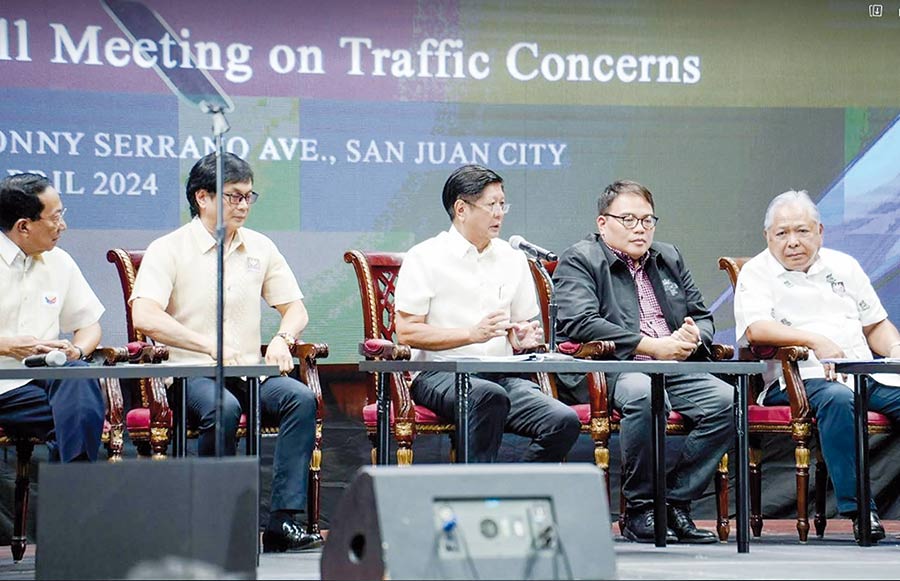By JOCELYN MONTEMAYOR and MYLA IGLESIAS
President Marcos Jr. yesterday said the government will pursue the development of mass transport system, especially in urban centers, as this will be the key to addressing traffic congestion.
“ (Mass transportation) that is the ultimate solution. That is what we are pursuing to expand, to hasten the mass transport system, to transfer commuters of buses, tricycles, jeeps or even private vehicles to the mass transit system,” the President said at the Bagong Pilipinas Town Hall in San Juan City.
He, however, said the construction of the needed infrastructure is still ongoing and would take time to complete.
The President enumerated the ongoing projects and their completion rate: North-South Commuter Railway project from Tutuban in Manila to Malolos in Bulacan, 61 percent; North-South Commuter Railway Extension Project from Malolos to Clark in Pampanga, 56.5 percent ; North-South Commuter Railway Extension Project-South extension from Manila to Calamba, 38 percent; Metro Manila Subway Project, 41 percent; LRT Line 1- Cavite extension, 80 percent; MRT Line 3 rehabilitation and maintenance, 85 percent ; Unified Grand Central station or the Quezon City common station, 83 percent; and the MRT line from Quezon City to Bulacan, 67 percent.
Marcos said these mass transportation infrastructure or anti-traffic projects are a priority of the government.
The President said traffic congestion takes a heavy toll on the economy, of about P3.5 billion in losses daily.
“If we do not do anything, this could go up to almost P9 billion per day. The analysis of NEDA (National Economic and Development Authority and the Department of Finance is, we lose P3.5 billion, or what we call opportunity cost. Time is wasted and productivity drops because people are waiting for vehicles,” he added.
He said all issues that contribute to the traffic situation should be addressed such as dumping of garbage on streets, training of more traffic enforcers and issues of right -of- way (ROW) that delay the projects, among others.
He said the design and maintenance of these infrastructure projects should take into account future growth.
Marcos said traffic solutions to be implemented in Metro Manila would eventually be replicated in other urban areas such as Cebu and Davao where traffic congestion is becoming a problem.
“We have to prioritize this problem. It is important for the quality of life of our people… for the growth of our economy. It is so important for the balanced development of the entire country, not just Metro Manila,” he said in mixed English and Filipino.
Another measure that the government is looking at is the transfer of some regional government agencies outside of Metro Manila to limit the travel of people going to the National Capital Region (NCR).
The President said some departments still maintain regional offices in Metro Manila, such as those from the Calabarzon region, instead of opening them in the actual region.
Marcos also wants roadworks and repairs done in the evening or when there is less traffic to avoid congestion.
He said urged local government units and other stakeholders to come up with more solution to ease traffic.
Accelerate completion
Meanwhile, the Department of Transportation (DOTr) and the Department of Public Works and Highways called for inter-agency coordination in accelerating the completion of rail and road projects to ease traffic in Metro Manila.
“The success of our transport projects hinges on their timely completion, requiring the cooperation of multiple agencies. It requires a cohesive effort with agencies,” said Jaime Bautista, DOTr secretary.
Bautista said transport projects will offer private vehicle owners a better alternative, resulting to lesser vehicles on the roads.
DPWH Secretary Manuel Bonoan said the agency has identified more than 10 road and bridge infrastructure projects that will ease traffic flow and improve transportation efficiency in Metro Manila.
Bonoan said DPWH’s traffic decongestion program involves the expansion, upgrading of transportation infrastructure, and construction of new roads and bridges to alleviate bottlenecks and provide alternative routes. The program also focuses on improving and expanding the national road network by building more by-passes, diversion roads, expressways, flyovers, interchanges and underpasses.
Updates on roads, bridges
The DPWH also gave a following rundown on ongoing projects: The main line of the 18-kilometer Metro Manila Skyway Stage 3 has reduced travel time from Buendia to Balintawak from two hours to 15 to 20 minutes; project segment from Tomas Claudio-Polytechnic University of the Philippines Sta. Mesa is ongoing, and 22 out of 28 ramps are completed, three are ongoing and the other three ramps are under the planning stage; the 7.7-km North Luzon Expressway-South Luzon Expressway (SLEX) Connector road is targeted to be fully operational this year;
ROW acquisition is ongoing for the 32-km Southeast Metro Manila Expressway, which will reduce travel time from Bicutan to Batasan from two hours to 30 minutes.; C5 South Link Expressway which will reduce travel time from R-1 Expressway to SLEX/C5 from 40 minutes to 10 minutes; detailed engineering design of Laguna Lakeshore Road Network Project-Phase I is 97 percent complete; and the 44-km Cavite-Laguna Expressway project is partially complete.
The DPWH is also prioritizing the construction of new bridges crossing Pasig River and Manggahan Floodway.
Three bridges in Metro Manila have so far been completed and operational: Binondo-Intramuros Bridge, Bonifacio Global City-Ortigas Center Link road project and the Estrella-Pantaleon Bridge.
Three more bridge projects are ongoing, namely, civil works for the North & South Harbor Bridge and Palanca-Villegas Bridge crossing Pasig River which are targeted to start by the end of this year or early part of next year, while construction of Eastbank-Westbank Bridge 2 crossing Manggahan Floodway is set to commence in September.
One of the landmark projects, the P219-billion Bataan-Cavite Interlink Bridge across Manila Bay, is set to be the country’s longest bridge once constructed.
The detailed engineering design of the mega bridge project in Luzon is now 97 percent complete, with final approval of design plans currently ongoing.
Other key projects are the rehabilitation and replacement of Guadalupe and Lambingan bridges, set to commence this year.





